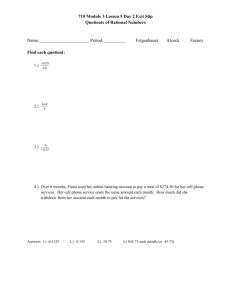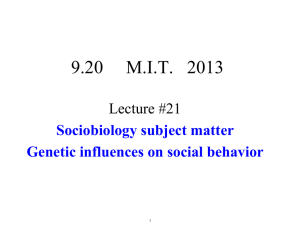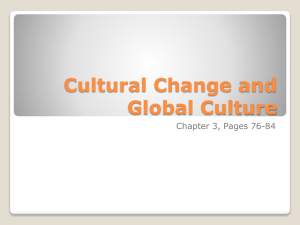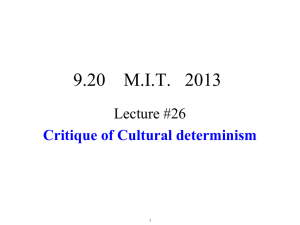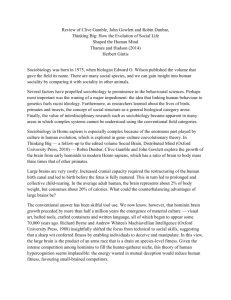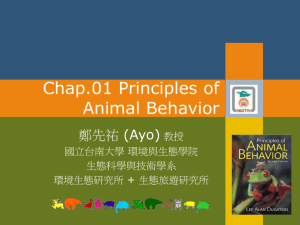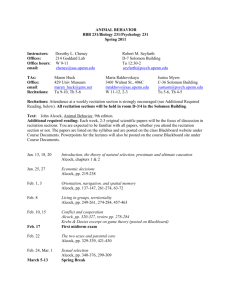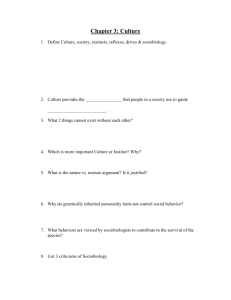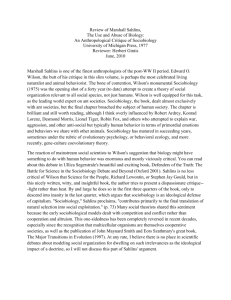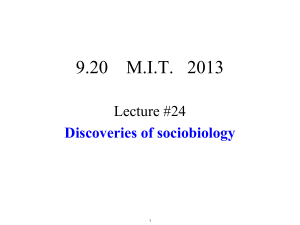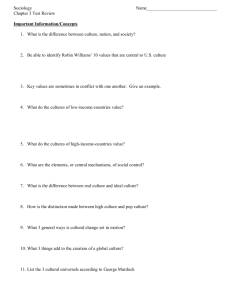9.20 M.I.T. 2013 Lecture #19 Sociobiology, introduction
advertisement
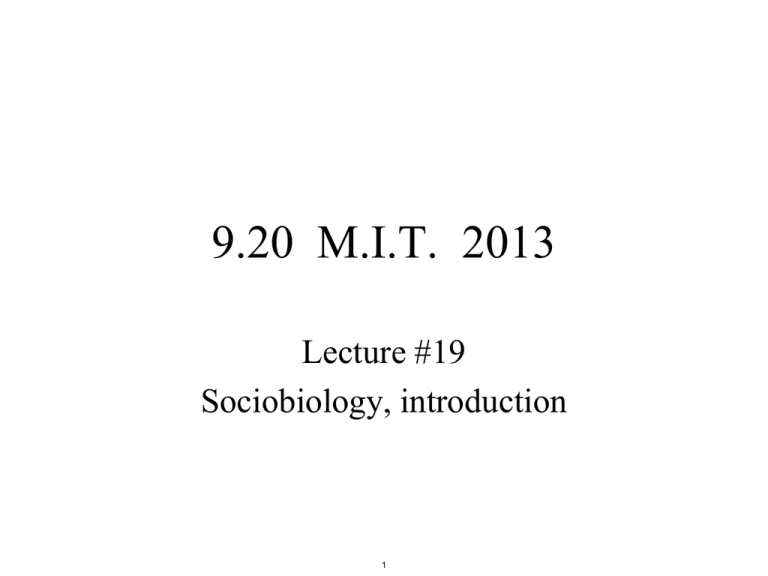
9.20 M.I.T. 2013 Lecture #19 Sociobiology, introduction 1 John Alcock, The Triumph of Sociobiology, Intro.: “Burn this book!” 1. Why did a group of scientists (especially from Harvard and MIT) write a manifesto, published in the New York Review of Books in 1975, against a large new book by Edward O. Wilson (of Harvard) entitled Sociobiology: The New Synthesis? pp 3-5: Their claims p 20: The intense political activity of the mid-1970s Students: See the original letter. How convincing do you find the arguments in the letter? Are you able to find flaws in these arguments without studying Alcock? 2 John Alcock, The Triumph of Sociobiology, Intro.: “Burn this book!” 1. Why did a group of scientists (especially from Harvard and MIT) write a manifesto, published in the New York Review of Books in 1975, against a large new book by Edward O. Wilson (of Harvard) entitled Sociobiology: The New Synthesis? pp 3-5: Their claims 1. 2. 3. Wilson’s theory could be used to justify existing social inequalities. It was founded on the kind of false science that had been used to support the eugenics policies of the Nazi party. See p 5 for Alcock’s list of misconceptions of people critical of or suspicious of sociobiology. All these claims will be discussed in Alcock’s book. 3 p 20: The intense political activity of the mid-1970s – – The anti-war movement, opposed to the war in Vietnam, included much intense political activity on campuses, much of it supported by left-leaning professors. The situation at Harvard: Lewontin and Gould were leaders in the group formed to oppose E.O. Wilson’s book, and many were believers in Marxist philosophy*, based on the idea of the perfectability of human institutions under Marxist political leadership. – – An evolved human nature that included social behavior was a threatening idea because it could be interpreted to mean that this behavior is rigidly determined. Thus, they and their group thought that sociobiological ideas could offer “ideological support for the enemy”—the rich and powerful (Alcock). * Members of the opposition group that were not Marxists simply believed that most human behavior of importance was learned and not inherited. They championed "nurture" over "nature" in the case of humans. 4 John Alcock, The Triumph of Sociobiology, ch 1: What kind of analysis? 2. What is the primary analytical tool of a sociobiologist? (I don’t mean a computer! See p 10.) 5 John Alcock, The Triumph of Sociobiology, ch 1: Why do whirligig beetles aggregate? 3. What simple experiment on the function of aggregations of whirligig beetles (fig 1.2) was carried out by Watt and Chapman, and what was the result? Was their question “proximate” or “ultimate” in nature, as these terms are defined by Alcock? And earlier by EO Wilson. p 10-12 What other questions could biologists (including neuroscientists) ask about the social behavior of these beetles? 6 John Alcock, The Triumph of Sociobiology, ch 1: Why do whirligig beetles aggregate? 3. What simple experiment on the function of aggregations of whirligig beetles (fig 1.2) was carried out by Watt and Chapman, and what was the result? Was their question “proximate” or “ultimate” in nature, as these terms are defined by Alcock? It was “ultimate” in nature: How is the behavior adaptive? i.e., how does it increase the probability that an individual will reproduce successfully? • Does it reduce the chances of an individual’s capture by a predator? • Does it increase the probability that an individual will be able to mate? 7 John Alcock, The Triumph of Sociobiology, ch 1: Why do whirligig beetles aggregate? 3. What simple experiment on the function of aggregations of whirligig beetles (fig 1.2) was carried out by Watt and Chapman, and what was the result? Was their question “proximate” or “ultimate” in nature, as these terms are defined pp 10-12 What other questions could biologists (including neuroscientists) ask about the social behavior of these beetles? by Alcock? “Proximate”: questions: – What sensory cues is a beetle using to recognize other members of its species? (What are the key stimuli?) – How does a beetle judge its distance from other beetles? – What are the nature of the IRMs? – What senses are being used, and what pathways in the nervous system are involved? – Does this behavior vary with specific hormonal levels? 8 John Alcock, The Triumph of Sociobiology, ch 1 Value of questions 4. Which kind of question (proximate or ultimate) is more important? p 12-13, 15 Neither, it depends on the purpose pursued by the scientist. 9 John Alcock, The Triumph of Sociobiology, ch 1 Beginnings of the science 5. How did the evolutionary analysis of behavior begin? p 17 10 Beginnings of the science: • Charles Darwin (1859), On the origin of species. • Charles Darwin (1872), The expression of the emotions in man and animals (republished, 1965, Univ Chicago Press, with introduction by K. Lorenz) • Note: Alfred Russel Wallace independently discovered the process of natural selection, which goaded Darwin into action. Darwin's strong evidence, together with his arguments, firmly established the theory of evolution by natural selection. It is sometimes called the Darwin-Wallace theory. • Illustrations from the 1872 book: 11 From Charles Darwin, The Expression of the Emotions in Man and Animals (1872) Similar in all dogs. Image is in public domain. 12 From Charles Darwin, The Expression of the Emotions in Man and Animals (1872) Similar in all dogs. Image is in public domain. 13 From Charles Darwin, The Expression of the Emotions in Man and Animals (1872) Similar in all humans. Remember the work of EiblEibesfeldt. 14 Photos are in public domain. John Alcock, The Triumph of Sociobiology, ch 1 Genetic variation 6. Why is variation within species so important for evolution? p 18 See Charles Darwin (1859), On the Origin of Species (London: Murray). He devoted an entire chapter to evidence for variation within living species. His theory of evolution by natural selection depends on the existence of variants within species. Thus, genetic diversity is critical for evolution. Without diversity, when environmental changes occur, a species may not be able to adapt successfully over multiple generations. When a species becomes endangered, the number of individuals may become small and many genes may be lost, reducing the chances of individual survival in the face of change. This could lead to extinction of the species. 15 Frequency of occurrence Distribution in one environment Distribution after multiple generations in a new environment Amount of a trait Most adaptive after change in environment (e.g. a new predator) 16 John Alcock, The Triumph of Sociobiology, ch 1 Creation of a new field 7. Did E. O. Wilson invent the field of Sociobiology? Discuss. p 16-19 (What was his primary field of basic research in biology?) Study of social insects. 17 John Alcock, The Triumph of Sociobiology, ch 1 Creation of a new field 7. Did E. O. Wilson invent the field of Sociobiology? Discuss. p 16-19 He invented the word, and synthesized the field. His review and arguments were forceful, and promoted the importance of research on "ultimate" issues in social behavior. 18 Antecedants of sociobiology: • Darwin (1859, 1872) • K. Lorenz, N. Tinbergen et al., Ethological studies of functions and evolution of innate behavior patterns (1920s & later) • Builders of the “modern synthesis” of evolutionary thinking (Ernst Mayr, Theodosius Dobzhansky, George Gaylord Simpson, and others): combined modern population genetics with theory of evolution by natural selection • William D. Hamilton (1964) “The genetical evolution of social behavior, I, II” , Journal of Theoretical Biology. • George C. Williams (1966) Adaptation and Natural Selection. • David Lack (1966) Population studies of birds. • Robert L. Trivers (1971) “The evolution of reciprocal altruism” • Richard D. Alexander (1971) “The search for an evolutionary philosophy of man”; (1974) “The evolution of social behavior”. • Jerram Brown (1974), “Alternate routes to sociality—with a theory for the evolution of altruism and communal breeding”. More about the highlighted individuals later. 19 From E. O. Wilson, Sociobiology, The Abridged Edition, p. 4 Figure removed due to copyright restrictions. 20 After 2000 Biopsych -ology Behavioral Neuroscience Cognitive Neuroscience Science Behavioral Ecology Ethology Sociobiology Psychology Evolutionary Psychology Population Biology Cell & Molecular Biology Proximate Questions Ultimate Questions 21 John Alcock, The Triumph of Sociobiology, ch 1 Appendix questions, p 225 Homework question #1: 1. Why do honeybees dance in the hive, communicating the location of nectar and pollen sources? What are some proximate and ultimate hypotheses? (Describe one ultimate and two proximate hypotheses.) 22 John Alcock, The Triumph of Sociobiology, ch 1 Appendix questions, p 225 Homework question #2: 2. Statement by Stephen Jay Gould: “An evolutionary speculation can only help if it teaches us something we don’t know already—if, for example, we learned that genocide was biologically enjoined by certain genes” (Natural History, 1996) • Why does this illustrate a failure to distinguish proximate and ultimate causes? 23 Homework Problem #3 (not from Alcock): Do a Google Scholar search for research articles on “sperm competition” published since 2008. Write a paragraph summarizing the findings of one article about a particular species that interests you. Limit your choice to non-human species (although the number of articles about human sperm competition has increased in recent years). 24 Next: Introduction to E.O. Wilson’s book (1975; abridged edition 1980) 25 Ch 1. THE MORALITY OF THE GENE Please see pages 3 and 4 in: Wilson, Edward. 0. Sociobiology: The New Synthesis." Harvard University Press (1980). 26 Ch. 2. ELEMENTARY CONCEPTS OF SOCIOBIOLOGY • Definitions – Population • A set of organisms belonging to the same species and occupying a clearly delimited area at the same time. • The population is bounded by a zone of sharply reduced gene flow. (Compare with “society” below.) – Deme: The special population used by model builders, defined as the smallest local set of organisms within which interbreeding occurs freely. – Species: a population or set of populations within which the individuals are capable of freely interbreeding under natural conditions. – Society: The society is bounded by a zone of sharply reduced communication. 27 Ch. 2. ELEMENTARY CONCEPTS OF SOCIOBIOLOGY, continued • "Social homeostasis": regulation of colony populations, caste proportions, etc. • The multiplier effect, p.9. – Occurs when a small evolutionary change in individual behavior results in major effects on social behavior patterns. – Example: baboons, hamadryas vs. olive: Hamadryas males “possess” particular females long-term, whereas Olive males do so only during estrus periods of females. Result: great differences in social structure. • The “evolutionary pacemaker”: – Evolutionary changes in behavior generally occur before changes in body structures involved in the behavior. Wolfgang Wicker has found good evidence of this in fishes & birds (p 10). – Example: the puffer fishes • What starts as adaptive anti-predator behavior has evolved into structural properties of some species within the same group of fishes. 28 Ch. 2. ELEMENTARY CONCEPTS OF SOCIOBIOLOGY, continued • “Adaptive demography”: relative proportions of individuals of different ages and sizes can be influenced by selection in favor of groups*vs the individual (p. 11). * of certain ages • Behavioral scaling (p. 14): With no difference in genetics, behaviors can change as a function of conditions. E.g., increases in population density can drastically alter aggression and territoriality. • Evolution leads to compromises in social evolution, as adaptations at one level may not be adaptations at another level (e.g., individual, family, population levels). • Ultimate vs. proximate causation. 29 To be continued 30 MIT OpenCourseWare http://ocw.mit.edu 9.20 Animal Behavior Fall 2013 For information about citing these materials or our Terms of Use, visit: http://ocw.mit.edu/terms.
